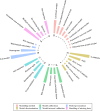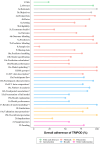The reporting quality and methodological quality of dynamic prediction models for cancer prognosis
- PMID: 40025462
- PMCID: PMC11872325
- DOI: 10.1186/s12874-025-02516-2
The reporting quality and methodological quality of dynamic prediction models for cancer prognosis
Abstract
Background: To evaluate the reporting quality and methodological quality of dynamic prediction model (DPM) studies on cancer prognosis.
Methods: Extensive search for DPM studies on cancer prognosis was conducted in MEDLINE, EMBASE, and the Cochrane Library databases. The Transparent Reporting of a Multivariable Prediction Model for Individual Prognosis or Diagnosis (TRIPOD) and the Prediction model Risk of Bias Assessment Tool (PROBAST) were used to assess reporting quality and methodological quality, respectively.
Results: A total of 34 DPM studies were identified since the first publication in 2005, the main modeling methods for DPMs included the landmark model and the joint model. Regarding the reporting quality, the median overall TRIPOD adherence score was 75%. The TRIPOD items were poorly reported, especially the title (23.53%), model specification, including presentation (55.88%) and interpretation (50%) of the DPM usage, and implications for clinical use and future research (29.41%). Concerning methodological quality, most studies were of low quality (n = 30) or unclear (n = 3), mainly due to statistical analysis issues.
Conclusions: The Landmark model and joint model show potential in DPM. The suboptimal reporting and methodological qualities of current DPM studies should be improved to facilitate clinical application.
Keywords: Cancer prognosis; Dynamic prediction models; Methodological characteristics; Methodological quality; Reporting quality.
© 2025. The Author(s).
Conflict of interest statement
Declarations. Ethics approval and consent to participate: Not applicable. Consent for publication: Not applicable. Competing interests: The authors declare no competing interests.
Figures





Similar articles
-
Prognostic models for predicting clinical disease progression, worsening and activity in people with multiple sclerosis.Cochrane Database Syst Rev. 2023 Sep 8;9(9):CD013606. doi: 10.1002/14651858.CD013606.pub2. Cochrane Database Syst Rev. 2023. PMID: 37681561 Free PMC article. Review.
-
Protocol for a systematic review on the methodological and reporting quality of prediction model studies using machine learning techniques.BMJ Open. 2020 Nov 11;10(11):e038832. doi: 10.1136/bmjopen-2020-038832. BMJ Open. 2020. PMID: 33177137 Free PMC article.
-
Poor reporting of multivariable prediction model studies: towards a targeted implementation strategy of the TRIPOD statement.BMC Med. 2018 Jul 19;16(1):120. doi: 10.1186/s12916-018-1099-2. BMC Med. 2018. PMID: 30021577 Free PMC article.
-
Transparent reporting of a multivariable prediction model for individual prognosis or diagnosis (TRIPOD): the TRIPOD statement.Br J Cancer. 2015 Jan 20;112(2):251-9. doi: 10.1038/bjc.2014.639. Epub 2015 Jan 6. Br J Cancer. 2015. PMID: 25562432 Free PMC article.
-
Transparent Reporting of a multivariable prediction model for Individual Prognosis Or Diagnosis (TRIPOD): the TRIPOD Statement.Br J Surg. 2015 Feb;102(3):148-58. doi: 10.1002/bjs.9736. Br J Surg. 2015. PMID: 25627261 Review.
References
-
- Moons KG, Royston P, Vergouwe Y, Grobbee DE, Altman DG. Prognosis and prognostic research: what, why, and how? BMJ (Clinical Res ed). 2009;338(b375). 10.1136/bmj.b375. - PubMed
-
- Beulens JWJ, Yauw JS, Elders PJM, Feenstra T, Herings R, Slieker RC, Moons KGM, Nijpels G, van der Heijden AA. Prognostic models for predicting the risk of foot ulcer or amputation in people with type 2 diabetes: a systematic review and external validation study. Diabetologia. 2021;64(7):1550–62. 10.1007/s00125-021-05448-w. - PMC - PubMed
-
- Dhiman P, Ma J, Navarro CA, Speich B, Bullock G, Damen JA, Kirtley S, Hooft L, Riley RD, Van Calster B, et al. Reporting of prognostic clinical prediction models based on machine learning methods in oncology needs to be improved. J Clin Epidemiol. 2021;138:60–72. 10.1016/j.jclinepi.2021.06.024. - PMC - PubMed
-
- Streiff MB, Holmstrom B, Angelini D, Ashrani A, Bockenstedt PL, Chesney C, Fanikos J, Fenninger RB, Fogerty AE, Gao S, et al. NCCN guidelines insights: Cancer-Associated venous thromboembolic disease, version 2.2018. J Natl Compr Cancer Netw J Natl Compr Canc Netw. 2018;16(11):1289–303. 10.6004/jnccn.2018.0084. - PubMed
MeSH terms
Grants and funding
LinkOut - more resources
Full Text Sources
Medical

